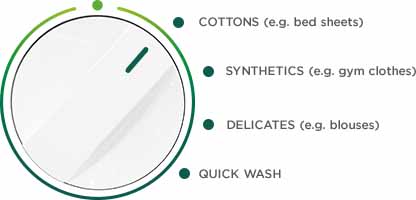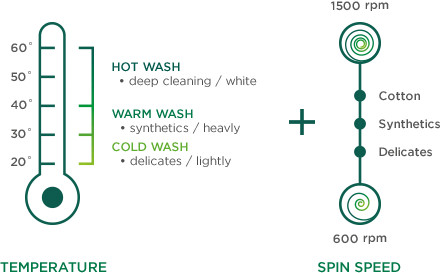Picking a washing cycle is no easy task, especially when you’re faced with lots of dials, numbers and settings.
You may not know which fabric can be washed on which setting, and it may be tempting to throw everything in, put on a quick wash cycle, and hope for the best. Read on to find out how to choose the right wash cycle for your laundry needs, and what those temperature and spin settings mean on your machine.
How to choose the right wash cycle
Choosing the right wash cycle is important when it comes to caring for your clothes. Wash your synthetic colourful t-shirt on a cotton setting and you might find it has faded after about 10 washes. Washing on the cotton setting can fade the colour and bring out the whiteness of the fabric that’s underneath the colour. This is why you should always check and follow the fabric care label as these recommend the right wash cycle setting.

Choose your Cycle
The most common washing cycle options include:
COTTONS. This is suitable for cotton garments or clothes that require a high agitation wash, like bed sheets and towels. This usually comes with a high-speed spin setting, which makes it a little harsher on clothes and is why it’s not recommended for more delicate fabrics.
SYNTHETICS. This offers a medium agitation wash often coupled with a low-speed spin that’s best for synthetic fabrics, such as your favourite acrylic blended jumper or polyester sportswear.
DELICATES. This is ideal for wool, lingerie, or blouses that can be washed in the machine. This is a low agitation wash with a lower speed spin, that’s suitable for lacy knickers or that silk blouse.
QUICK WASH. This is ideal if you need your washing done in under half an hour, but it’s usually only recommended for lightly soiled clothes. This cycle has a shortened wash cycle and a high-speed spin cycle, to also speed up the drying time as well. This is not recommended for delicate items, like silks, lingerie, or anything with beading.
HAND WASH. You may have a hand wash cycle on your washing machine, which can be used for clothes that have ‘hand wash only’ listed on the fabric care label. It’s suitable for very delicate garments like silk, soft cottons, delicate linens, wool garments made from thin wools like angora, or garments with sequins or beads. The low speeds of agitation and low speed spins help prevent stretching and ripping of the fabric.
Some washing machines also give you a temperature range for each setting. For example, cotton can range from 30°C to 90°C, and delicates can go from 30°C to 40°C. Finding the right temperature setting is also extremely important when it comes to doing the laundry.
Which temperature should I wash my clothes on?
Most washing machines can wash at all kinds of temperatures, from cold washes as low as 15°C to hot cotton washes at up to 90°C. Sometimes picking the right temperature can be daunting. While the fabric care label will give you the maximum recommended temperature for your garment, here’s a rough guide on when to use certain temperatures:

Hot washes (60°C and above) are best for washing tough stain items or items that contain high levels of bacteria, for instance clothes worn by someone who has been ill. Separate the laundry and wash with Ariel Powder for the best results.

Warm washes (40°C) are best for items that have come into contact with body fluids, such as underwear. Wash such garments on warm temperatures with Ariel.

Cold washes (15-30°C) should be used for lightly- to moderately-soiled daily items. Washing on cold wash also protects brightly coloured garments from fading and prevents dye transfer. The cool wash is gentler on clothes and uses less energy too. Wash with Ariel Gel, and you can get brilliant cleaning results even on temperatures as low as 15°C.
Using a detergent like Ariel Gel can help you see better stain removal results, dissolving at any temperature to work efficiently even at lower wash temperatures.
What’s the right spin speed for my garments?
Selecting the right spin speed can be a juggling act between getting stains out and caring for your clothes. Usually the spin cycle is determined by the wash cycle you pick, but if you have to set the spin cycle on your washer, or you want to customise your cycle, then the general rule of thumb is:
More agitation (e.g. cotton cycles) = better cleaning and stain removal, but less fabric care.
Less agitation (e.g. delicates) = better fabric care, but less cleaning and stain removal power.
Synthetic fabrics fall more or less in the middle when it comes to picking a spin cycle between the high spin required for cottons, and the low spin needed for delicates.
Mix your own Cycle

Washing machines may seem complicated, but the good thing is you have a helping hand from the fabric care labels on the inside of your clothes. Whether you want to pick the fastest washing machine cycle or one that offers a deeper clean, as long as you follow the instructions on the labels and follow our tips on how to do your laundry, you can be sure your clothes will stay looking their best for longer. You can also see our cheat sheet below on different wash cycles, to help you wash your clothes better.
| Wash cycle | When to use it | How it cleans |
|---|---|---|
| COTTONS | To remove dirt and stains for durable fabric. i.e. sheets, towels, whites, heavily-soiled items, cotton underwear and socks. | • High agitation wash • High-speed spin cycle • Adjustable temperature |
| SYNTHETICS | Everyday washing for synthetic garments with medium soiling. i.e. blended and synthetic fabrics, like polyester, jeans, and jumpers | • Medium agitation wash • Low-speed spin cycle • Warm-to-cool temperature |
| DELICATES | Gentle cleaning for delicate items. i.e. Lingerie, silk, wool, knits, and other delicate fabrics. | • Low agitation wash • Low-speed spin cycle |
| QUICK WASH | Everyday washing that needs to be done quickly, with minimal soiling, but not for delicate garments. | • Shortened wash cycle • High-speed spin cycle |
| HAND WASH | Gentle cleaning for very delicate, ‘hand wash only’ garments. | • Low speeds of agitation • Low-speed spins |
| Wash temperature | How and when to use it |
|---|---|
| HOT WASH 60°C AND ABOVE | Use to remove the toughest stains and clean clothes worn by someone who has been sick. Use a powder detergent for the best results. |
| WARM WASH 40°C | Wash items that have been in contact with body fluids, such as underwear, on 40°C. |
| COLD WASH 30°C OR BELOW | Wash lightly- to moderately-soiled items from your daily laundry load on low temperatures. |
